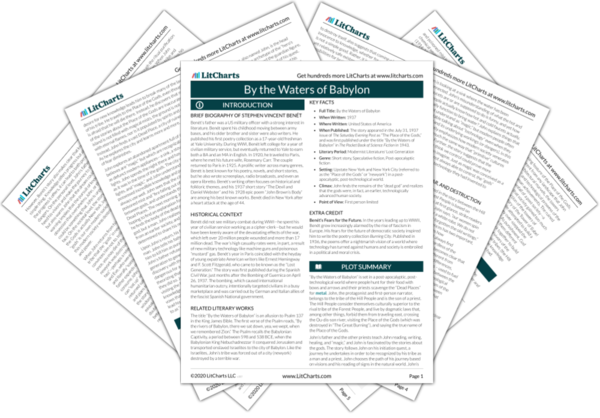Welcome to the LitCharts study guide on Stephen Vincent Benét's By the Waters of Babylon. Created by the original team behind SparkNotes, LitCharts are the world's best literature guides.
Waters of Babylon: Introduction
A concise biography of Stephen Vincent Benét plus historical and literary context for By the Waters of Babylon.
Waters of Babylon: Plot Summary
A quick-reference summary: By the Waters of Babylon on a single page.
Waters of Babylon: Detailed Summary & Analysis
In-depth summary and analysis of every of By the Waters of Babylon. Visual theme-tracking, too.
Waters of Babylon: Themes
Explanations, analysis, and visualizations of By the Waters of Babylon's themes.
Waters of Babylon: Quotes
By the Waters of Babylon's important quotes, sortable by theme, character, or .
Waters of Babylon: Characters
Description, analysis, and timelines for By the Waters of Babylon's characters.
Waters of Babylon: Symbols
Explanations of By the Waters of Babylon's symbols, and tracking of where they appear.
Waters of Babylon: Theme Wheel
An interactive data visualization of By the Waters of Babylon's plot and themes.
Brief Biography of Stephen Vincent Benét
Benét’s father was a US military officer with a strong interest in literature. Benét spent his childhood moving between army bases, and his older brother and sister were also writers. He published his first poetry collection as a 17-year-old freshman at Yale University. During WWI, Benét left college for a year of civilian military service, but eventually returned to Yale to earn both a BA and an MA in English. In 1920, he traveled to Paris, where he met his future wife, Rosemary Carr. The couple returned to Paris in 1925. A prolific writer across many genres, Benét is best known for his poetry, novels, and short stories, but he also wrote screenplays, radio broadcasts, and even an opera libretto. Benét’s writing often focuses on historical and folkloric themes, and his 1937 short story “The Devil and Daniel Webster” and his 1928 epic poem “John Brown’s Body” are among his best known works. Benét died in New York after a heart attack at the age of 44.
Get the entire Waters of Babylon LitChart as a printable PDF.

Historical Context of By the Waters of Babylon
Benét did not see military combat during WWI—he spent his year of civilian service working as a cipher-clerk—but he would have been keenly aware of the devastating effects of the war, which left over 20 million people wounded and more than 17 million dead. The war’s high casualty rates were, in part, a result of new military technology like machine guns and poisonous “mustard” gas. Benét’s year in Paris coincided with the heyday of young expatriate American writers like Ernest Hemingway and F. Scott Fitzgerald, who came to be known as the “Lost Generation.” The story was first published during the Spanish Civil War, just months after the Bombing of Guernica on April 26, 1937. The bombing, which caused international humanitarian outcry, intentionally targeted civilians in a busy marketplace and was carried out by German and Italian allies of the fascist Spanish National government.
Other Books Related to By the Waters of Babylon
The title “By the Waters of Babylon” is an allusion to Psalm 137 in the King James Bible. The first verse of the Psalm reads, “By the rivers of Babylon, there we sat down, yea, we wept, when we remembered Zion.” The Psalm recalls the Babylonian Captivity, a period between 598 and 538 BCE, when the Babylonian King Nebuchadnezzar II conquered Jerusalem and transported enslaved Israelites to the city of Babylon. Like the Israelites, John’s tribe was forced out of a city (newyork) destroyed by a terrible war.
Key Facts about By the Waters of Babylon
- Full Title: By the Waters of Babylon
- When Written: 1937
- Where Written: United States of America
- When Published: The story appeared in the July 31, 1937 issue of The Saturday Evening Post as “The Place of the Gods,” and was first published under the title “By the Waters of Babylon” in The Pocket Book of Science Fiction in 1943.
- Literary Period: Modernist Literature/ Lost Generation
- Genre: Short story, Speculative fiction, Post-apocalyptic fiction
- Setting: Upstate New York and New York City (referred to as the “Place of the Gods” or “newyork”) in a post-apocalyptic, post-technological world.
- Climax: John finds the remains of the “dead god” and realizes that the gods were, in fact, an earlier, technologically advanced human society.
- Point of View: First person limited
Extra Credit for By the Waters of Babylon
Benét’s Fears for the Future. In the years leading up to WWII, Benét grew increasingly alarmed by the rise of fascism in Europe. His fears for the future of democratic society inspired him to write the poetry collection Burning City. Published in 1936, the poems offer a nightmarish vision of a world where technology has turned against humans and society is embroiled in a political and moral crisis.












